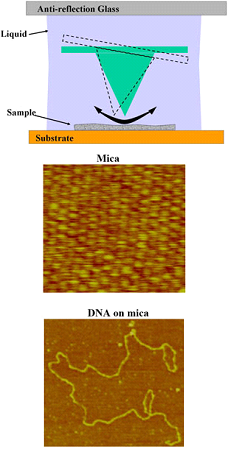
Current atomic force microscopy (AFM) modes mainly use the flexural deflection (static or dynamic) of the cantilever as the feedback input to maintain the tip-sample separation. However, it is relatively difficult to determine the contact point with the flexural modes because most long-range forces are acting in the normal direction. In contrast, the torsion resonance (TR) mode is affected by the lateral force gradient acting on the tip only, and the lateral forces starts to occur only when the tip is getting in contact with the sample surface. We have used the frequency shift of the torsion resonance as the feedback control. The frequency shift exhibits a sharp jump from zero upon contact and is a monotonic function of the tip-sample distance, similar to the behavior of the tunneling current in STM. We have demonstrated atomic resolution on a mica surface in water with a relatively blunt tip and the lateral force is negligibly small. Our imaging of DNA on mica surfaces in solution exhibits a height around 2 nm, very close to the diameter of DNA determined with X-ray diffraction. This indicates very small loading force applied by the tip. Thus this soft-contact TR mode is very suitable for imaging soft biological samples in liquid. In addition, our measurements indicate that even long and soft cantilevers can achieve a Q value of 50-70 with the TR mode in water. The Q factor and the resonant frequency of the first torsion resonance in water is about two orders of magnitude higher than those of the fundamental flexural resonance, and thus the TR mode may provide a higher force sensitivity than the dynamic flexural mode. The result has been published on Nanotechnology 21, 065710 (2010).